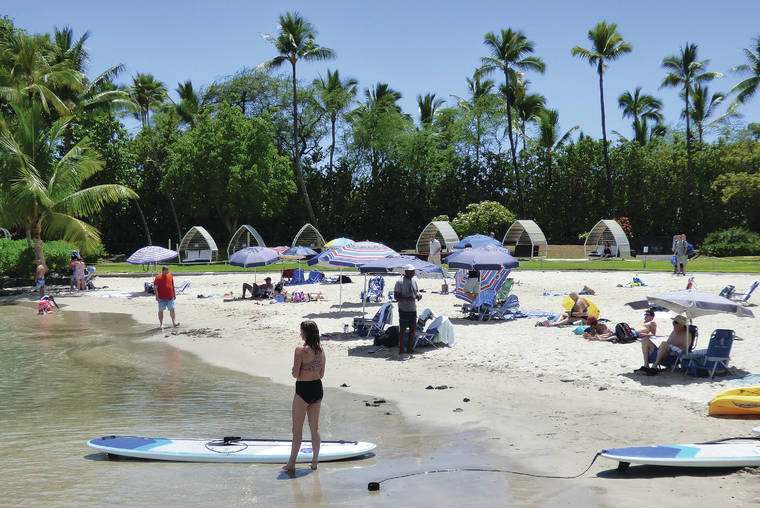The state Department of Business, Economic Development and Tourism is projecting domestic visitor arrivals will recover to pre-pandemic levels by the end of the year.
That prediction was included in DBEDT’s second-quarter statistical and economic report, which was released Wednesday. DBEDT revised its economic growth projection for 2021 upward to 3.5% from the 2.7% growth the department predicted in February.
In a statement, DBEDT Director Mike McCartney said the ongoing recovery in the state’s visitor industry is “accelerating from the domestic markets in the past few months.”
McCartney said the uptick in domestic visitors will be especially beneficial economically for the neighbor islands. He noted that in 2019, prior to the coronavirus pandemic, visitors to Hawaii County from the U.S. mainland made up 77.2% of the visitor market — while only 57.1% of Oahu’s visitors two years ago were from the mainland.
“As of April this year, there were still 41,000 workers waiting to be called back in the hospitality sector alone,” McCartney said, referring to statewide layoffs, furloughs and dismissals in the visitor industry.
“We really rely on tourism, and it’s starting to come back. But not all jobs are being called back, right?” Anne Perreira-Eustaquio, director of the state Department of Labor and Industrial Relations, said Wednesday during a Facebook Live stream.
Referring to Gov. David Ige’s recent announcement that unemployment insurance claimants will be required to list three weekly job search contacts starting Sunday, Perreira-Eustaquio said that requirement doesn’t apply to those classified as “partial claimants.” Those are unemployment claimants who were full-time employees prior to filing their claim, but have been cut to partial hours, or who were furloughed but are still considered employed.
“We also know that employers are calling back workers — but in temporary positions, only,” Perreira-Eustaquio said. “So, if you are being called back temporarily, and being paid partial, you do not have to look for work.”
According to Perreira-Eustaquio, there are still about 153,000 active regular unemployment insurance claims, plus 38,000 active Pandemic Unemployment Assistance claims from individuals who lost income from independent contracting or the so-called “gig economy.”
The state’s unemployment rate without seasonal adjustment stood at 8.1% in April, while Hawaii County’s unemployment rate was 7.9%. That compares to 21.9% for the state and 22% for the county in April 2020 when visitors all but stopped coming to Hawaii because of the pandemic and quarantines imposed on trans-Pacific arrivals.
On Wednesday, there were 23,192 trans-Pacific arrivals at the state’s four major airports, including 2,692 in Kailua-Kona. That compares to just 966 trans-Pacific arrivals on May 25, 2020, exactly a year earlier, with only 58 touching down first in Kona.
DBEDT is now projecting the state’s visitor arrivals will number 6.6 million this year, about 64% of the 2019 level. That projection is about 1.1 million more than predicted in the first quarter of this year. The state is now projecting visitor arrivals to increase to 8.6 million in 2022, 9.5 million in 2023 and 10.1 million in 2024.
One factor driving that projected uptick, according to DBEDT, is an increase in vaccination rates here and on the mainland.
As of Monday, 39% of Americans were fully vaccinated while 49.5% had received at least one shot of vaccine. Those numbers are better in Hawaii, with 46.9% of residents fully vaccinated and 65.3% receiving at least one dose. That ranks Hawaii No. 2 nationwide in terms of residents receiving at least one dose, and No. 7 for fully vaccinated residents.
The majority of Americans are expected to be fully vaccinated by the end of July, and visitor counts are expected to take another leap forward at that point, according to the report.
That said, full recovery of tourism to pre-pandemic levels won’t occur until beyond 2024, according to projections. McCartney attributed that to a “lagging in tourism recovery from the international market.”
International arrivals this year are still projected to be about 5% of pre-pandemic levels because of low vaccination rates in other countries and the continuation of COVID breakouts in places such as Japan.
In 2019, international arrivals to Hawaii accounted for one-third of total visitors, and their daily spending was higher than that for mainland U.S. visitors, $216 per day versus $188 per day.
The only industry in Hawaii with a better recovery rate than tourism is construction, according to the report. In April, the statewide construction economy was 1.9% higher than the pre-pandemic level recorded in January 2020.
The construction industry job count for April was 37,100 — up from 36,400 in January 2020 and 34,000 in April 2020.
The full report is available at dbedt.hawaii.gov/economic/qser.
Email John Burnett at jburnett@hawaiitribune-herald.com.

